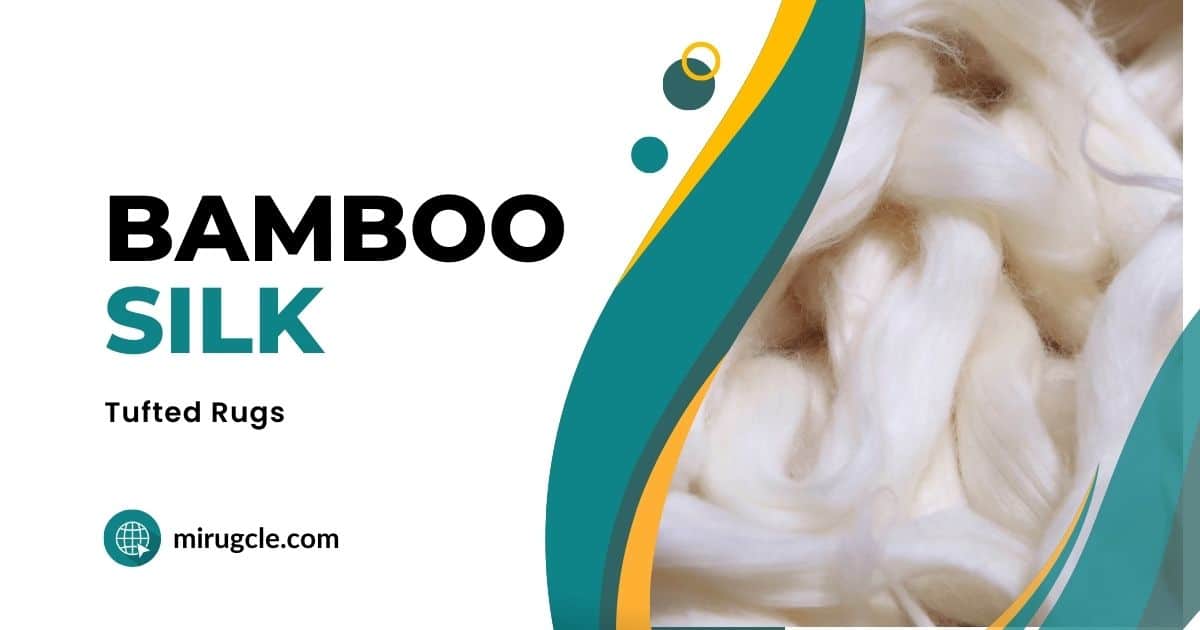Discover the allure and benefits of bamboo silk in tufted rugs.
In this post, you’ll learn about the unique characteristics of bamboo silk, its eco-friendly nature, and how it compares to traditional silk and wool.
Find out why bamboo silk is a cost-effective and sustainable choice for luxurious rugs.
Uncover insights into the best applications for bamboo silk in your home.
Dive in now to elevate your rug knowledge!
Bamboo silk is a type of fiber used in handmade rugs, including hand-tufted rugs.
It is made from the cellulose fibers extracted from bamboo plants and processed to create a soft, lustrous material that resembles silk.
Key characteristics of bamboo silk used in tufted rugs:
- Appearance – Bamboo silk has a smooth, shiny appearance similar to traditional silk.
It adds luster and an elegant sheen to rug designs. - Texture – Rugs made with bamboo silk have a very soft, smooth texture.
The fibers feel luxurious and silky to the touch. - Durability – While very soft, bamboo silk fibers are also strong and durable.
Bamboo silk rugs can withstand traffic better than those made from traditional silk. - Eco-friendly – Bamboo is a highly renewable resource that grows quickly without pesticides.
Bamboo silk is considered a more sustainable alternative to traditional silk. - Cost-effective – Rugs made with bamboo silk provide the look and feel of expensive silk rugs at a lower price point.
Bamboo silk is more affordable than traditional silk. - Moisture-wicking – Bamboo silk has natural breathability and moisture-wicking properties, helping to keep rugs fresh.
- In hand-tufted rugs, bamboo silk is often blended with wool, with the silk adding sheen and softness while the wool provides structure.
The bamboo silk highlights and enhances the pattern and colors of the rug design. - While very beautiful and luxurious, bamboo silk rugs are best suited for low-traffic areas and may not be as durable as wool rugs.
However, they provide an elegant and more affordable alternative to traditional silk rugs.
Bamboo Silk vs Traditional Silk
Bamboo silk and traditional silk have some similarities, but also key differences in terms of their origin, production process, and properties:
Origin
- Traditional silk is produced by silkworms, specifically the Bombyx mori species, which feed on mulberry leaves.
- Bamboo silk is made from cellulose fibers extracted from bamboo plants.
Production process
- Traditional silk is made by unraveling the cocoons spun by silkworms and then spinning the fine filaments into silk threads.
- Bamboo silk is produced through a chemical process that extracts cellulose from bamboo and transforms it into fiber form, similar to rayon production.
Properties
- Both traditional silk and bamboo silk are known for their softness, smoothness, and luxurious feel.
- Bamboo silk has a texture similar to a blend of cashmere and silk.
It may not be quite as smooth as the finest traditional silk. - Bamboo silk is very breathable and has excellent moisture-wicking properties.
- Traditional silk is the strongest natural fiber, while bamboo silk is also strong and durable.
- Bamboo silk is considered more environmentally friendly and sustainable, as bamboo is a fast-growing renewable resource.
- Bamboo silk tends to be more affordable than traditional silk due to differences in the production process and raw materials.
In summary, while bamboo silk mimics the feel and drape of traditional silk, it comes from a plant-based source and has some unique properties like enhanced breathability and moisture-wicking.
However, high-quality traditional silk is still considered the ultimate in smoothness and luxury.
Bamboo Silk versus Wool
Here are the key points comparing bamboo silk and wool yarn for tufted rugs:
Similarities
- Both bamboo silk and wool are soft, lustrous materials that can create beautiful, high-end looking rugs.
- Rugs made from both fibers are durable, though wool is generally more durable and better for high-traffic areas.
Differences
- Bamboo silk is a plant-based viscose fiber, while wool comes from sheep.
- Bamboo silk has a smooth, silky feel very similar to real silk.
Wool has a soft texture but is not as smooth as bamboo silk. - Bamboo silk is usually more affordable than wool, especially compared to high-quality wool like New Zealand wool.
- Bamboo silk is considered more eco-friendly and sustainable since bamboo grows very quickly without pesticides.
Wool is also a renewable fiber. - Bamboo silk fibers are more absorbent and prone to staining compared to wool, which has natural stain-resistance.
- Bamboo silk fibers can be crushed more easily by heavy furniture compared to the resilient fibers in a wool rug.
Common practices
- Tufted rugs often use a blend of 70% wool and 30% bamboo silk to get the benefits of both fibers – the sheen and softness of bamboo silk with the durability of wool.
- 100% bamboo silk rugs are better suited for low-traffic areas, while wool or wool-bamboo silk blends are better for high-traffic areas.
In summary, while both bamboo silk and wool create beautiful, soft tufted rugs, wool is more durable and practical, especially for high-traffic areas.
Bamboo silk provides a more affordable and eco-friendly silk alternative but with less resilience.
A blend of the two fibers is very common to get the aesthetic of bamboo silk with the functionality of wool.

